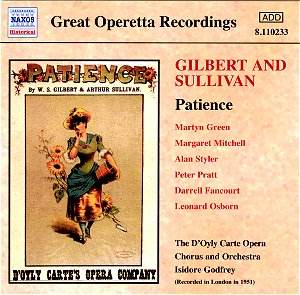Arthur
Sullivan was one of Britainís important composers of the Victorian
age. Although remembered chiefly for his G&S operas some gems
are to be found amongst his other theatre music, songs, symphony
and oratorio. He received his musical training, firstly as a chorister
(Chapel Royal) and later as a student at the Royal Academy of
Music, London. A Mendelssohn scholarship took him to Leipzig where
he studied the music of the German romantics. As a composer he
was skilled in providing catchy melodies and songs with good orchestration.
His example even led to the cultivation of a unique genre of English
operetta, the Savoy Opera.
With witty
lyrics by W.S. Gilbert, the Gilbert & Sullivan comic operas
have stood the test of time and are still popular today [type
'Gilbert & Sullivan' in your search engine to find all sites
and links]. The partnership between Gilbert and Sullivan was initiated
by the enterprising theatre manager, Richard D'Oyly Carte. It
was Carte who brought them together to write fourteen comic operas,
the sixth of which was Patience.
This Patience
recording was released in the Festival of Britain year
(1951) and much effort was made to ensure that the production
was of optimum quality. As with earlier recordings, the specification
of the orchestra amounts to an augmented theatre orchestra. The
playing is excellent in every way even if the strings lack that
fullness we expect nowadays. Under the direction of D'Oyly Carte's
resident musical director, Isidore Godfrey, we are given a lively
reading with more sensitivity than that expressed in some of Sargent's
EMI recordings of the period.
This particular
Patience recording is unique for those who follow the cast
history of the D'Oyly Carte company. It is the only occasion when
the two principal patter leads play together in the same recording.
The principal tenor is sung by both the retiring Osborn and a
step-in Griffiths.
Of the cast,
Martyn Green, Ella Halman, Ann Drummond-Grant and Leonard Osborn
were long-serving Savoyards who played these roles on stage both
pre-war and post-war. Margaret Mitchell and Alan Styler joined
the company in the 1940s. We thus have an experienced stage-performing
cast brought into the studio. These are all names remembered with
affection by the over-sixties. Green had directly replaced Henry
Lytton who in the last decade of his career became a poor singer.
(In the earlier 78s HMV Sargent electric recordings (c.1930) Lytton's
parts were played by George Baker who had never appeared on stage
yet offered HMV excellent diction and clarity of voice.) It is
probably the marked contrast with Lytton that has caused Green
to be remembered so warmly. Like Baker, Green's musicality and
diction is good.
Margaret Mitchell
is a confident, warm-toned soprano who portrays the naïve
but common sense Patience admirably. Ann Drummond-Grant, wife
of Isidore Godfrey, was a long-serving member of the company by
the time of this recording. Starting out as a soprano, her pleasant
characteristic voice had mellowed to a rich mezzo by the time
of this recording. Her velvety timbre and attention to dynamics
is captured here nicely. The ageing Leonard Osborn was ill during
the recording sessions and only sings in track 12 'In rite
sacrificial'. He is replaced by Neville Griffiths for the
rest of the recording, a youthful tenor whom I personally prefer.
Ella Halman is a suitably dominant Lady Jane with characteristically
heavy timbre and usual clear diction, as was Gillian Knight who
followed her. Alan Styler's 'A magnet hung in a hardware shop'
is enjoyable yet he doesn't seem to exude the radiance provided
by Kenneth Sandford in the later Decca recording.
The orchestra
and musical direction is confident under Godfrey though the piece
lacks in dynamics when compared with the later recording.
The recording
has a medium acoustic avoiding the characteristic 'box' effect
of the early post-war recordings. The more spacious Watford and
Walthamstow Town Hall locations with their modern miking of the
Savoy Operas was yet to arrive.
A note about
the transcription: unlike some of the earlier operas in this series
that were cut as 78 matrices, this one was recorded as an early
tape master.
Further information:
Bk. Gilbert & Sullivan, Ainger (Routledge 2003) with review
at http://www.musicweb-international.com/classrev/2003/Mar03/ainger.htm
Raymond
Walker


![]() Libretto by William S.
Gilbert (1836-1911)
Libretto by William S.
Gilbert (1836-1911) ![]() NAXOS 8.110233 [70.38]
NAXOS 8.110233 [70.38]